Business Model Canvas Analysis of Foodora: A Comprehensive Report
VerifiedAdded on 2023/01/10
|14
|2640
|60
Report
AI Summary
This report presents a comprehensive analysis of Foodora's business model using the Business Model Canvas framework. It begins with an executive summary and an introduction to Foodora, a restaurant delivery service. The report then delves into the nine building blocks of the business model, including customer segments (individuals, families, students, and business people), key partners (restaurants), value propositions (satisfying hunger, high-quality food, diverse menus, fast delivery), key activities (fast food delivery), channels (social media, website), revenue streams (commissions, delivery fees), cost structure (marketing, staff), key resources (partnerships, cyclists), and customer relationships (high-quality food, live support, fast delivery). The analysis explores interrelationships between the building blocks, critical success factors (customer relationships, distribution channels), and potential downside risks (marketing costs, employee compensation). The report concludes with recommendations for improving the business model, such as developing restaurants under the Foodora brand and expanding the employee base and fleet of cyclists. The report includes tables and appendices for additional data and insights. This assignment is a student contribution to Desklib, a platform offering AI-powered study tools.
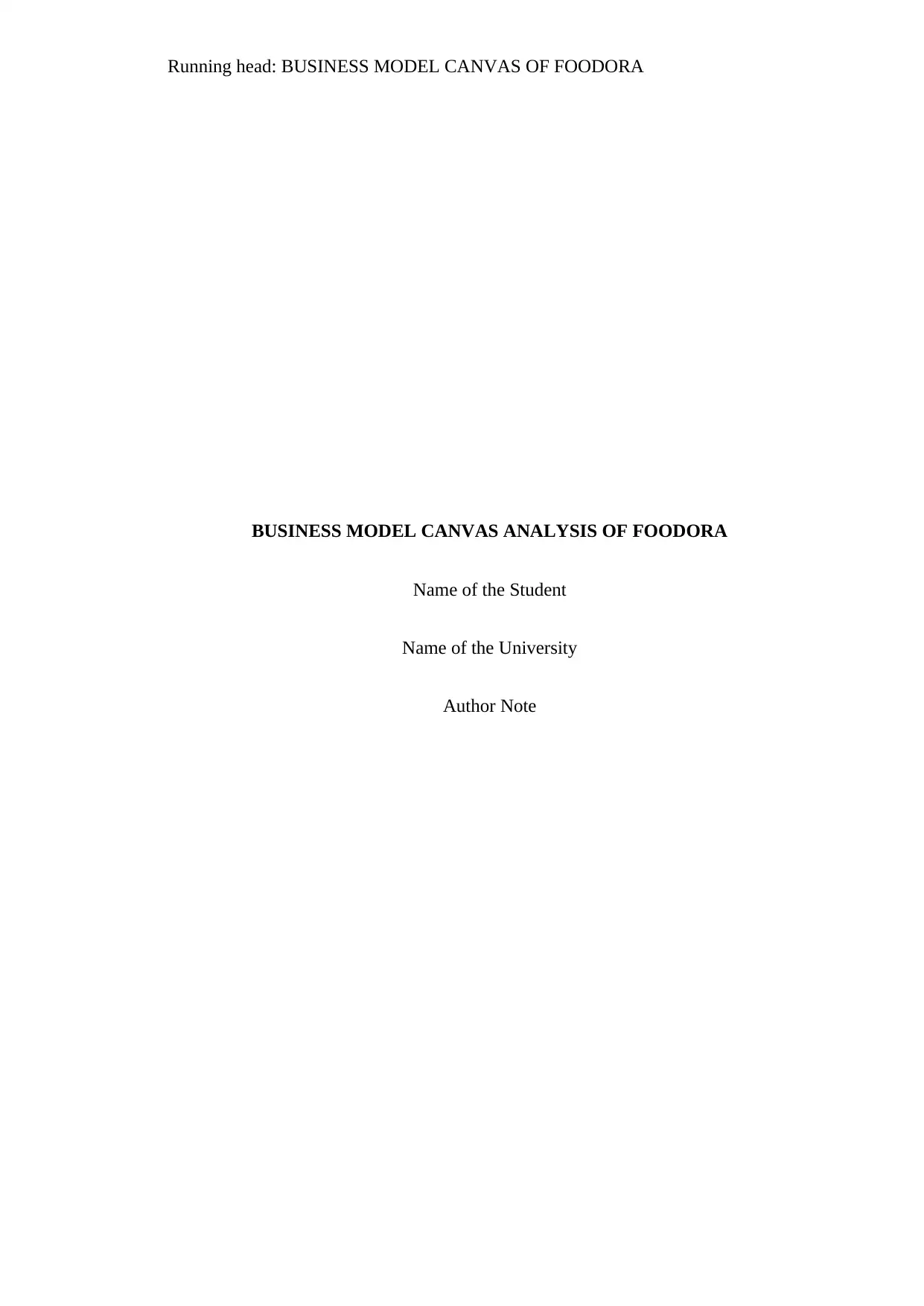
Running head: BUSINESS MODEL CANVAS OF FOODORA
BUSINESS MODEL CANVAS ANALYSIS OF FOODORA
Name of the Student
Name of the University
Author Note
BUSINESS MODEL CANVAS ANALYSIS OF FOODORA
Name of the Student
Name of the University
Author Note
Paraphrase This Document
Need a fresh take? Get an instant paraphrase of this document with our AI Paraphraser
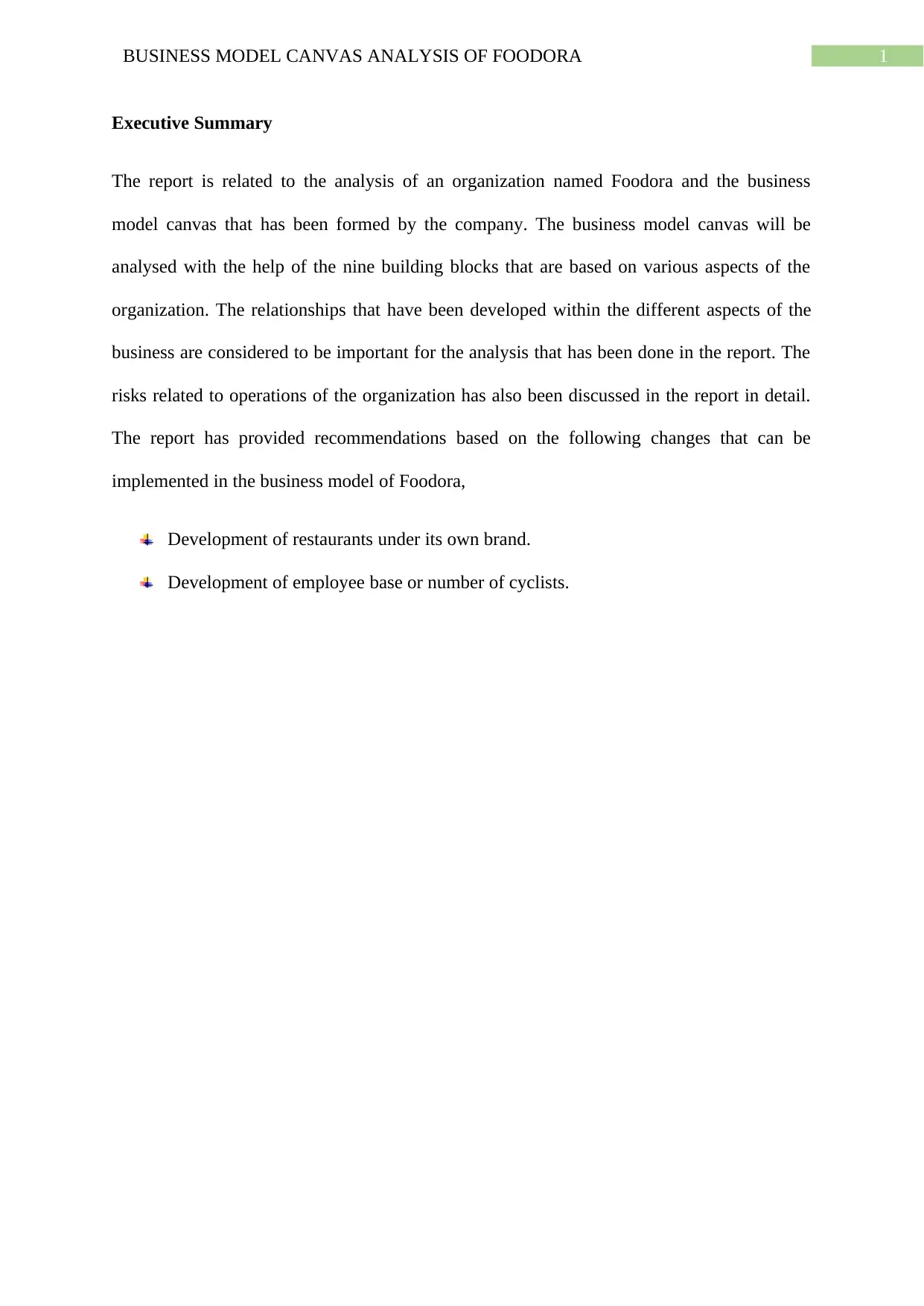
1BUSINESS MODEL CANVAS ANALYSIS OF FOODORA
Executive Summary
The report is related to the analysis of an organization named Foodora and the business
model canvas that has been formed by the company. The business model canvas will be
analysed with the help of the nine building blocks that are based on various aspects of the
organization. The relationships that have been developed within the different aspects of the
business are considered to be important for the analysis that has been done in the report. The
risks related to operations of the organization has also been discussed in the report in detail.
The report has provided recommendations based on the following changes that can be
implemented in the business model of Foodora,
Development of restaurants under its own brand.
Development of employee base or number of cyclists.
Executive Summary
The report is related to the analysis of an organization named Foodora and the business
model canvas that has been formed by the company. The business model canvas will be
analysed with the help of the nine building blocks that are based on various aspects of the
organization. The relationships that have been developed within the different aspects of the
business are considered to be important for the analysis that has been done in the report. The
risks related to operations of the organization has also been discussed in the report in detail.
The report has provided recommendations based on the following changes that can be
implemented in the business model of Foodora,
Development of restaurants under its own brand.
Development of employee base or number of cyclists.
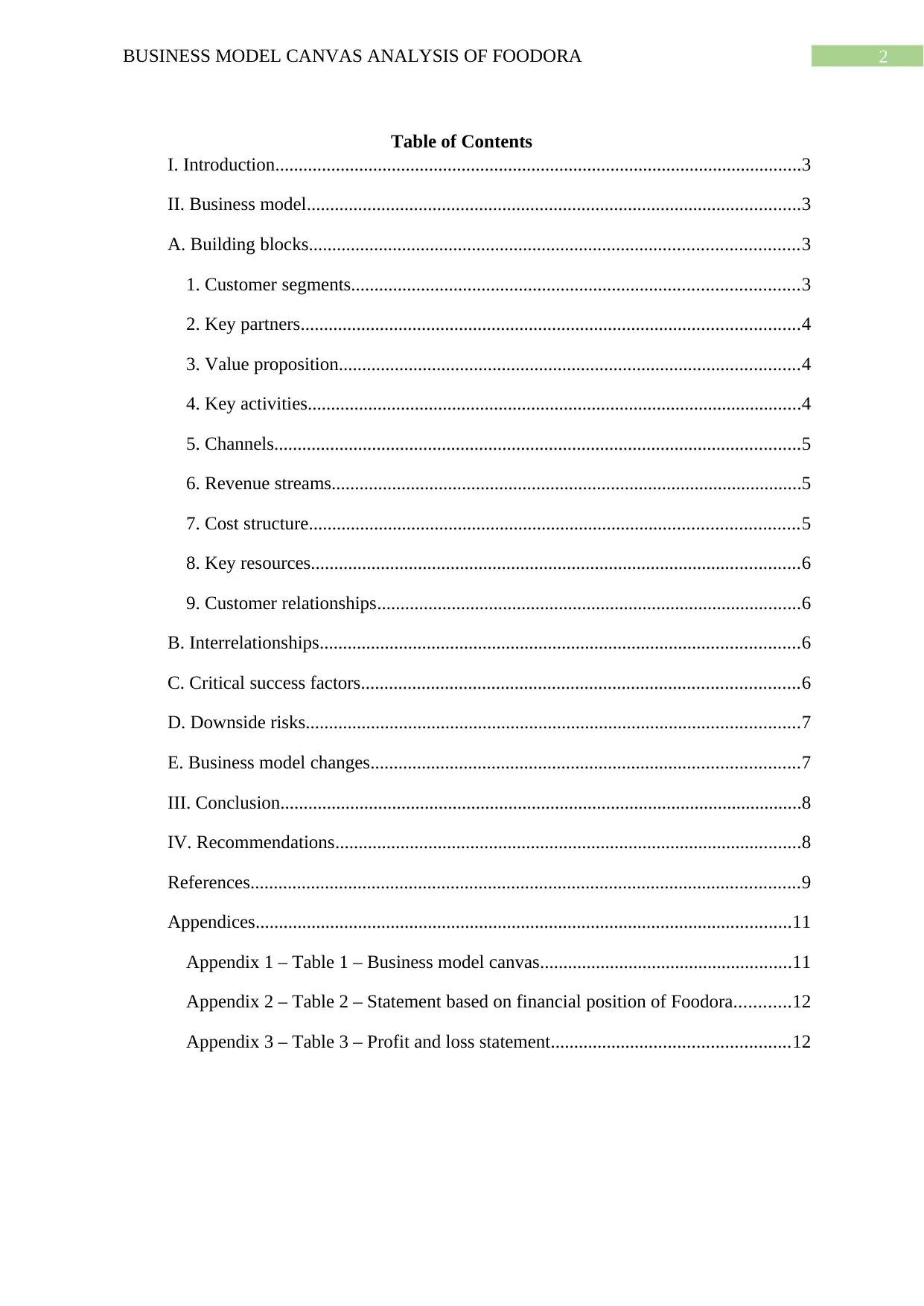
2BUSINESS MODEL CANVAS ANALYSIS OF FOODORA
Table of Contents
I. Introduction.................................................................................................................3
II. Business model..........................................................................................................3
A. Building blocks.........................................................................................................3
1. Customer segments................................................................................................3
2. Key partners...........................................................................................................4
3. Value proposition...................................................................................................4
4. Key activities..........................................................................................................4
5. Channels.................................................................................................................5
6. Revenue streams.....................................................................................................5
7. Cost structure.........................................................................................................5
8. Key resources.........................................................................................................6
9. Customer relationships...........................................................................................6
B. Interrelationships.......................................................................................................6
C. Critical success factors..............................................................................................6
D. Downside risks..........................................................................................................7
E. Business model changes............................................................................................7
III. Conclusion................................................................................................................8
IV. Recommendations....................................................................................................8
References......................................................................................................................9
Appendices...................................................................................................................11
Appendix 1 – Table 1 – Business model canvas......................................................11
Appendix 2 – Table 2 – Statement based on financial position of Foodora............12
Appendix 3 – Table 3 – Profit and loss statement...................................................12
Table of Contents
I. Introduction.................................................................................................................3
II. Business model..........................................................................................................3
A. Building blocks.........................................................................................................3
1. Customer segments................................................................................................3
2. Key partners...........................................................................................................4
3. Value proposition...................................................................................................4
4. Key activities..........................................................................................................4
5. Channels.................................................................................................................5
6. Revenue streams.....................................................................................................5
7. Cost structure.........................................................................................................5
8. Key resources.........................................................................................................6
9. Customer relationships...........................................................................................6
B. Interrelationships.......................................................................................................6
C. Critical success factors..............................................................................................6
D. Downside risks..........................................................................................................7
E. Business model changes............................................................................................7
III. Conclusion................................................................................................................8
IV. Recommendations....................................................................................................8
References......................................................................................................................9
Appendices...................................................................................................................11
Appendix 1 – Table 1 – Business model canvas......................................................11
Appendix 2 – Table 2 – Statement based on financial position of Foodora............12
Appendix 3 – Table 3 – Profit and loss statement...................................................12
⊘ This is a preview!⊘
Do you want full access?
Subscribe today to unlock all pages.

Trusted by 1+ million students worldwide
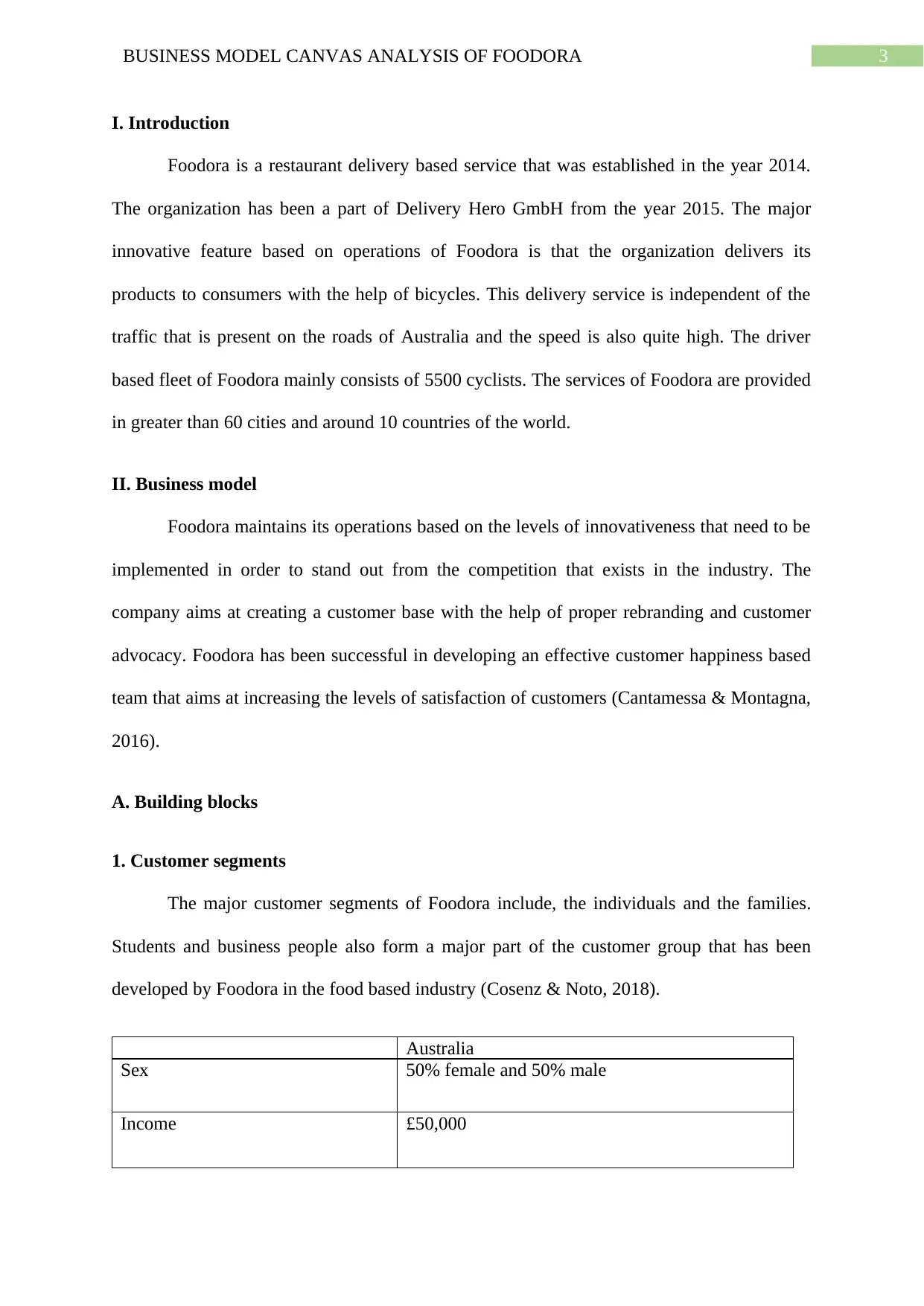
3BUSINESS MODEL CANVAS ANALYSIS OF FOODORA
I. Introduction
Foodora is a restaurant delivery based service that was established in the year 2014.
The organization has been a part of Delivery Hero GmbH from the year 2015. The major
innovative feature based on operations of Foodora is that the organization delivers its
products to consumers with the help of bicycles. This delivery service is independent of the
traffic that is present on the roads of Australia and the speed is also quite high. The driver
based fleet of Foodora mainly consists of 5500 cyclists. The services of Foodora are provided
in greater than 60 cities and around 10 countries of the world.
II. Business model
Foodora maintains its operations based on the levels of innovativeness that need to be
implemented in order to stand out from the competition that exists in the industry. The
company aims at creating a customer base with the help of proper rebranding and customer
advocacy. Foodora has been successful in developing an effective customer happiness based
team that aims at increasing the levels of satisfaction of customers (Cantamessa & Montagna,
2016).
A. Building blocks
1. Customer segments
The major customer segments of Foodora include, the individuals and the families.
Students and business people also form a major part of the customer group that has been
developed by Foodora in the food based industry (Cosenz & Noto, 2018).
Australia
Sex 50% female and 50% male
Income £50,000
I. Introduction
Foodora is a restaurant delivery based service that was established in the year 2014.
The organization has been a part of Delivery Hero GmbH from the year 2015. The major
innovative feature based on operations of Foodora is that the organization delivers its
products to consumers with the help of bicycles. This delivery service is independent of the
traffic that is present on the roads of Australia and the speed is also quite high. The driver
based fleet of Foodora mainly consists of 5500 cyclists. The services of Foodora are provided
in greater than 60 cities and around 10 countries of the world.
II. Business model
Foodora maintains its operations based on the levels of innovativeness that need to be
implemented in order to stand out from the competition that exists in the industry. The
company aims at creating a customer base with the help of proper rebranding and customer
advocacy. Foodora has been successful in developing an effective customer happiness based
team that aims at increasing the levels of satisfaction of customers (Cantamessa & Montagna,
2016).
A. Building blocks
1. Customer segments
The major customer segments of Foodora include, the individuals and the families.
Students and business people also form a major part of the customer group that has been
developed by Foodora in the food based industry (Cosenz & Noto, 2018).
Australia
Sex 50% female and 50% male
Income £50,000
Paraphrase This Document
Need a fresh take? Get an instant paraphrase of this document with our AI Paraphraser
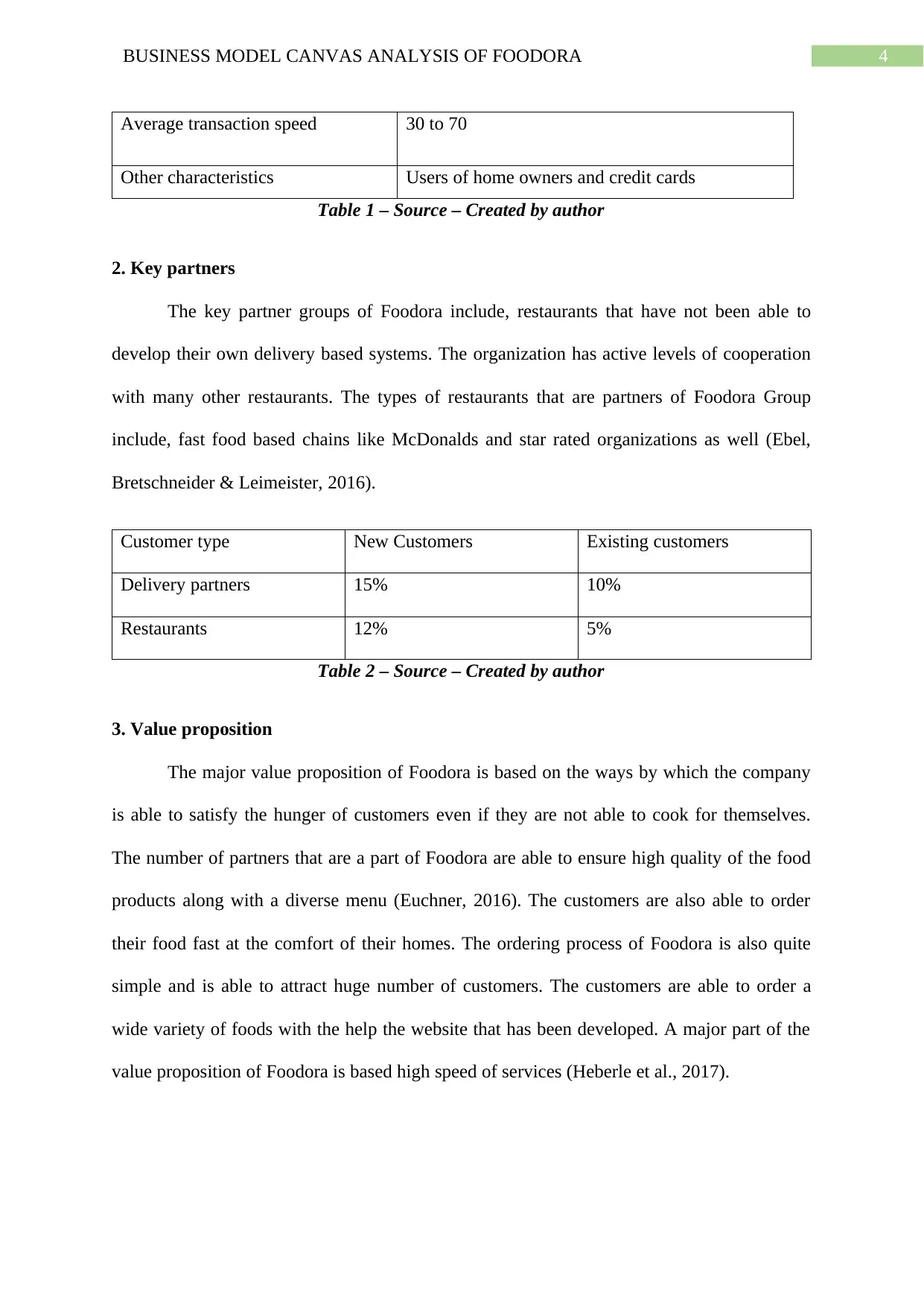
4BUSINESS MODEL CANVAS ANALYSIS OF FOODORA
Average transaction speed 30 to 70
Other characteristics Users of home owners and credit cards
Table 1 – Source – Created by author
2. Key partners
The key partner groups of Foodora include, restaurants that have not been able to
develop their own delivery based systems. The organization has active levels of cooperation
with many other restaurants. The types of restaurants that are partners of Foodora Group
include, fast food based chains like McDonalds and star rated organizations as well (Ebel,
Bretschneider & Leimeister, 2016).
Customer type New Customers Existing customers
Delivery partners 15% 10%
Restaurants 12% 5%
Table 2 – Source – Created by author
3. Value proposition
The major value proposition of Foodora is based on the ways by which the company
is able to satisfy the hunger of customers even if they are not able to cook for themselves.
The number of partners that are a part of Foodora are able to ensure high quality of the food
products along with a diverse menu (Euchner, 2016). The customers are also able to order
their food fast at the comfort of their homes. The ordering process of Foodora is also quite
simple and is able to attract huge number of customers. The customers are able to order a
wide variety of foods with the help the website that has been developed. A major part of the
value proposition of Foodora is based high speed of services (Heberle et al., 2017).
Average transaction speed 30 to 70
Other characteristics Users of home owners and credit cards
Table 1 – Source – Created by author
2. Key partners
The key partner groups of Foodora include, restaurants that have not been able to
develop their own delivery based systems. The organization has active levels of cooperation
with many other restaurants. The types of restaurants that are partners of Foodora Group
include, fast food based chains like McDonalds and star rated organizations as well (Ebel,
Bretschneider & Leimeister, 2016).
Customer type New Customers Existing customers
Delivery partners 15% 10%
Restaurants 12% 5%
Table 2 – Source – Created by author
3. Value proposition
The major value proposition of Foodora is based on the ways by which the company
is able to satisfy the hunger of customers even if they are not able to cook for themselves.
The number of partners that are a part of Foodora are able to ensure high quality of the food
products along with a diverse menu (Euchner, 2016). The customers are also able to order
their food fast at the comfort of their homes. The ordering process of Foodora is also quite
simple and is able to attract huge number of customers. The customers are able to order a
wide variety of foods with the help the website that has been developed. A major part of the
value proposition of Foodora is based high speed of services (Heberle et al., 2017).
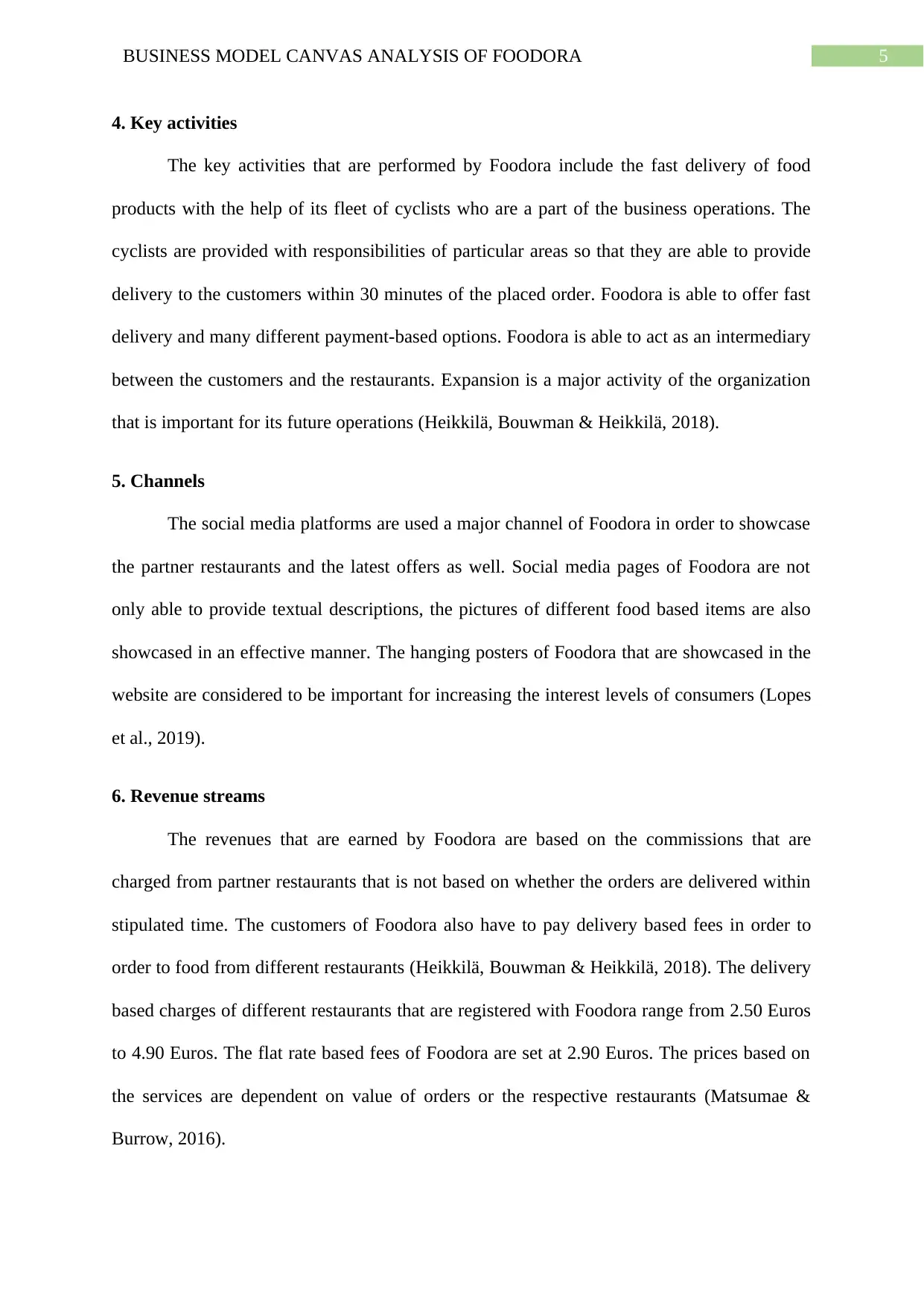
5BUSINESS MODEL CANVAS ANALYSIS OF FOODORA
4. Key activities
The key activities that are performed by Foodora include the fast delivery of food
products with the help of its fleet of cyclists who are a part of the business operations. The
cyclists are provided with responsibilities of particular areas so that they are able to provide
delivery to the customers within 30 minutes of the placed order. Foodora is able to offer fast
delivery and many different payment-based options. Foodora is able to act as an intermediary
between the customers and the restaurants. Expansion is a major activity of the organization
that is important for its future operations (Heikkilä, Bouwman & Heikkilä, 2018).
5. Channels
The social media platforms are used a major channel of Foodora in order to showcase
the partner restaurants and the latest offers as well. Social media pages of Foodora are not
only able to provide textual descriptions, the pictures of different food based items are also
showcased in an effective manner. The hanging posters of Foodora that are showcased in the
website are considered to be important for increasing the interest levels of consumers (Lopes
et al., 2019).
6. Revenue streams
The revenues that are earned by Foodora are based on the commissions that are
charged from partner restaurants that is not based on whether the orders are delivered within
stipulated time. The customers of Foodora also have to pay delivery based fees in order to
order to food from different restaurants (Heikkilä, Bouwman & Heikkilä, 2018). The delivery
based charges of different restaurants that are registered with Foodora range from 2.50 Euros
to 4.90 Euros. The flat rate based fees of Foodora are set at 2.90 Euros. The prices based on
the services are dependent on value of orders or the respective restaurants (Matsumae &
Burrow, 2016).
4. Key activities
The key activities that are performed by Foodora include the fast delivery of food
products with the help of its fleet of cyclists who are a part of the business operations. The
cyclists are provided with responsibilities of particular areas so that they are able to provide
delivery to the customers within 30 minutes of the placed order. Foodora is able to offer fast
delivery and many different payment-based options. Foodora is able to act as an intermediary
between the customers and the restaurants. Expansion is a major activity of the organization
that is important for its future operations (Heikkilä, Bouwman & Heikkilä, 2018).
5. Channels
The social media platforms are used a major channel of Foodora in order to showcase
the partner restaurants and the latest offers as well. Social media pages of Foodora are not
only able to provide textual descriptions, the pictures of different food based items are also
showcased in an effective manner. The hanging posters of Foodora that are showcased in the
website are considered to be important for increasing the interest levels of consumers (Lopes
et al., 2019).
6. Revenue streams
The revenues that are earned by Foodora are based on the commissions that are
charged from partner restaurants that is not based on whether the orders are delivered within
stipulated time. The customers of Foodora also have to pay delivery based fees in order to
order to food from different restaurants (Heikkilä, Bouwman & Heikkilä, 2018). The delivery
based charges of different restaurants that are registered with Foodora range from 2.50 Euros
to 4.90 Euros. The flat rate based fees of Foodora are set at 2.90 Euros. The prices based on
the services are dependent on value of orders or the respective restaurants (Matsumae &
Burrow, 2016).
⊘ This is a preview!⊘
Do you want full access?
Subscribe today to unlock all pages.

Trusted by 1+ million students worldwide

6BUSINESS MODEL CANVAS ANALYSIS OF FOODORA
7. Cost structure
The major costs that are incurred by Foodora are based on marketing activities that
are able to gain the attention of customers. Costs related to maintenance of staff in Foodora
are also quite high (Philipson, 2016).
8. Key resources
The key resources that have been gained by Foodora in the industry mainly include,
partnerships with the various restaurants and group of cyclists Foodora are also major
resources of the organization that provide support to its operations (Stampfl, 2015).
9. Customer relationships
Foodora aims at delivering high quality food to the customers in order to retain them
within the organization and provide special offers as well. Foodora can also provide live
support to the customers with the help of its website that is able to improve the solve the
issues that they face. Foodora is able to offer fast delivery to the customers and develop
effective services to them (Matsumae & Burrow, 2016).
B. Interrelationships
The number of deliveries that are made by Foodora are based on the channels that are
developed. The offers are provided to the customers of Foodora with the support of these
channels. Communication with customers is linked with the resources and channels. The
value propositions that have been developed by the company are able to affect proper usage
of resources (Ebel, Bretschneider & Leimeister, 2016). The partner restaurants of the
organization are able to support the ways by which food delivery services that are offered to
the customers. Revenue streams of the organization have an impact on the costs that are
incurred in development of services. Different segments of customers in the organization are
affected by the speed of food delivery services (Cantamessa & Montagna, 2016).
7. Cost structure
The major costs that are incurred by Foodora are based on marketing activities that
are able to gain the attention of customers. Costs related to maintenance of staff in Foodora
are also quite high (Philipson, 2016).
8. Key resources
The key resources that have been gained by Foodora in the industry mainly include,
partnerships with the various restaurants and group of cyclists Foodora are also major
resources of the organization that provide support to its operations (Stampfl, 2015).
9. Customer relationships
Foodora aims at delivering high quality food to the customers in order to retain them
within the organization and provide special offers as well. Foodora can also provide live
support to the customers with the help of its website that is able to improve the solve the
issues that they face. Foodora is able to offer fast delivery to the customers and develop
effective services to them (Matsumae & Burrow, 2016).
B. Interrelationships
The number of deliveries that are made by Foodora are based on the channels that are
developed. The offers are provided to the customers of Foodora with the support of these
channels. Communication with customers is linked with the resources and channels. The
value propositions that have been developed by the company are able to affect proper usage
of resources (Ebel, Bretschneider & Leimeister, 2016). The partner restaurants of the
organization are able to support the ways by which food delivery services that are offered to
the customers. Revenue streams of the organization have an impact on the costs that are
incurred in development of services. Different segments of customers in the organization are
affected by the speed of food delivery services (Cantamessa & Montagna, 2016).
Paraphrase This Document
Need a fresh take? Get an instant paraphrase of this document with our AI Paraphraser
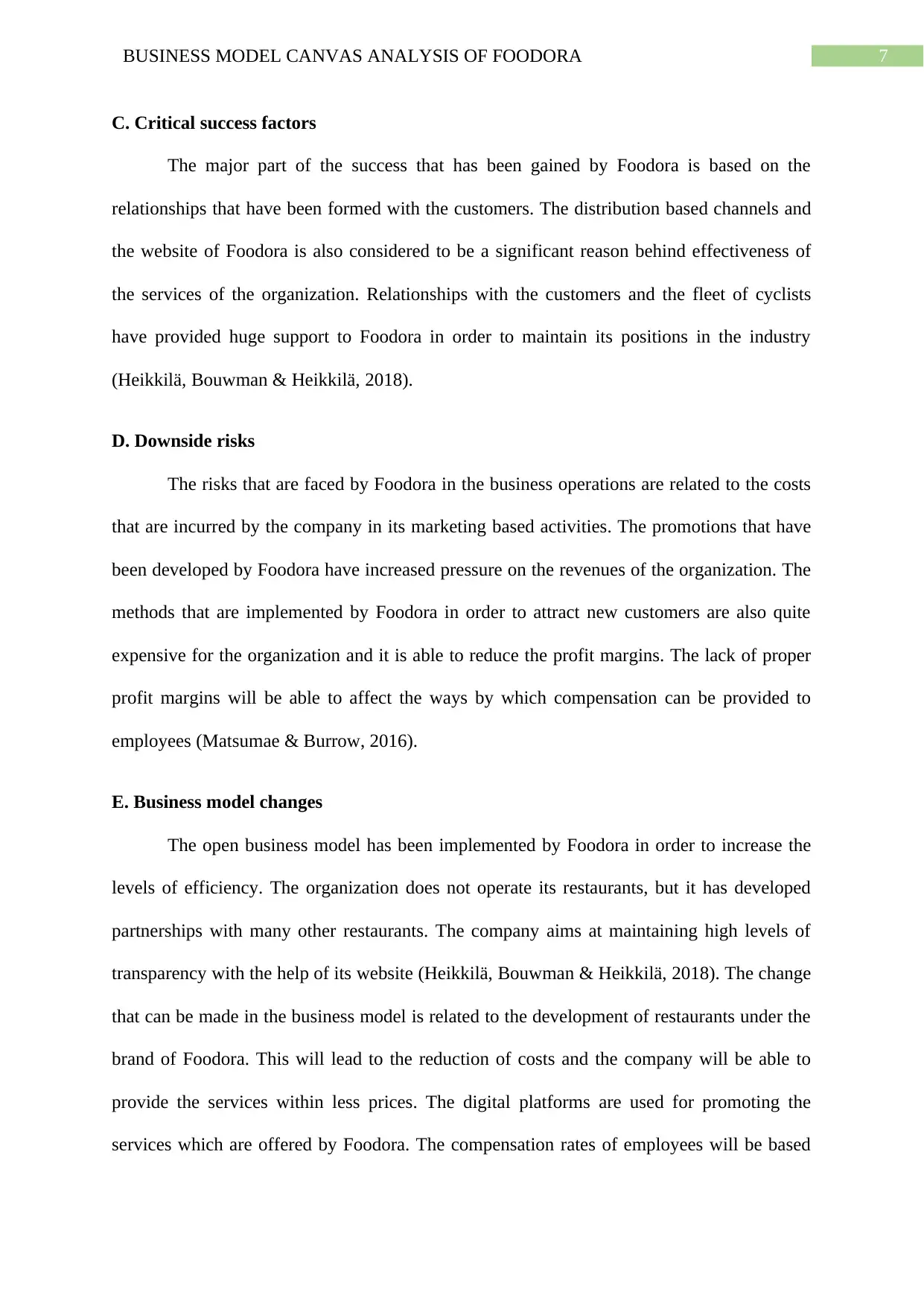
7BUSINESS MODEL CANVAS ANALYSIS OF FOODORA
C. Critical success factors
The major part of the success that has been gained by Foodora is based on the
relationships that have been formed with the customers. The distribution based channels and
the website of Foodora is also considered to be a significant reason behind effectiveness of
the services of the organization. Relationships with the customers and the fleet of cyclists
have provided huge support to Foodora in order to maintain its positions in the industry
(Heikkilä, Bouwman & Heikkilä, 2018).
D. Downside risks
The risks that are faced by Foodora in the business operations are related to the costs
that are incurred by the company in its marketing based activities. The promotions that have
been developed by Foodora have increased pressure on the revenues of the organization. The
methods that are implemented by Foodora in order to attract new customers are also quite
expensive for the organization and it is able to reduce the profit margins. The lack of proper
profit margins will be able to affect the ways by which compensation can be provided to
employees (Matsumae & Burrow, 2016).
E. Business model changes
The open business model has been implemented by Foodora in order to increase the
levels of efficiency. The organization does not operate its restaurants, but it has developed
partnerships with many other restaurants. The company aims at maintaining high levels of
transparency with the help of its website (Heikkilä, Bouwman & Heikkilä, 2018). The change
that can be made in the business model is related to the development of restaurants under the
brand of Foodora. This will lead to the reduction of costs and the company will be able to
provide the services within less prices. The digital platforms are used for promoting the
services which are offered by Foodora. The compensation rates of employees will be based
C. Critical success factors
The major part of the success that has been gained by Foodora is based on the
relationships that have been formed with the customers. The distribution based channels and
the website of Foodora is also considered to be a significant reason behind effectiveness of
the services of the organization. Relationships with the customers and the fleet of cyclists
have provided huge support to Foodora in order to maintain its positions in the industry
(Heikkilä, Bouwman & Heikkilä, 2018).
D. Downside risks
The risks that are faced by Foodora in the business operations are related to the costs
that are incurred by the company in its marketing based activities. The promotions that have
been developed by Foodora have increased pressure on the revenues of the organization. The
methods that are implemented by Foodora in order to attract new customers are also quite
expensive for the organization and it is able to reduce the profit margins. The lack of proper
profit margins will be able to affect the ways by which compensation can be provided to
employees (Matsumae & Burrow, 2016).
E. Business model changes
The open business model has been implemented by Foodora in order to increase the
levels of efficiency. The organization does not operate its restaurants, but it has developed
partnerships with many other restaurants. The company aims at maintaining high levels of
transparency with the help of its website (Heikkilä, Bouwman & Heikkilä, 2018). The change
that can be made in the business model is related to the development of restaurants under the
brand of Foodora. This will lead to the reduction of costs and the company will be able to
provide the services within less prices. The digital platforms are used for promoting the
services which are offered by Foodora. The compensation rates of employees will be based
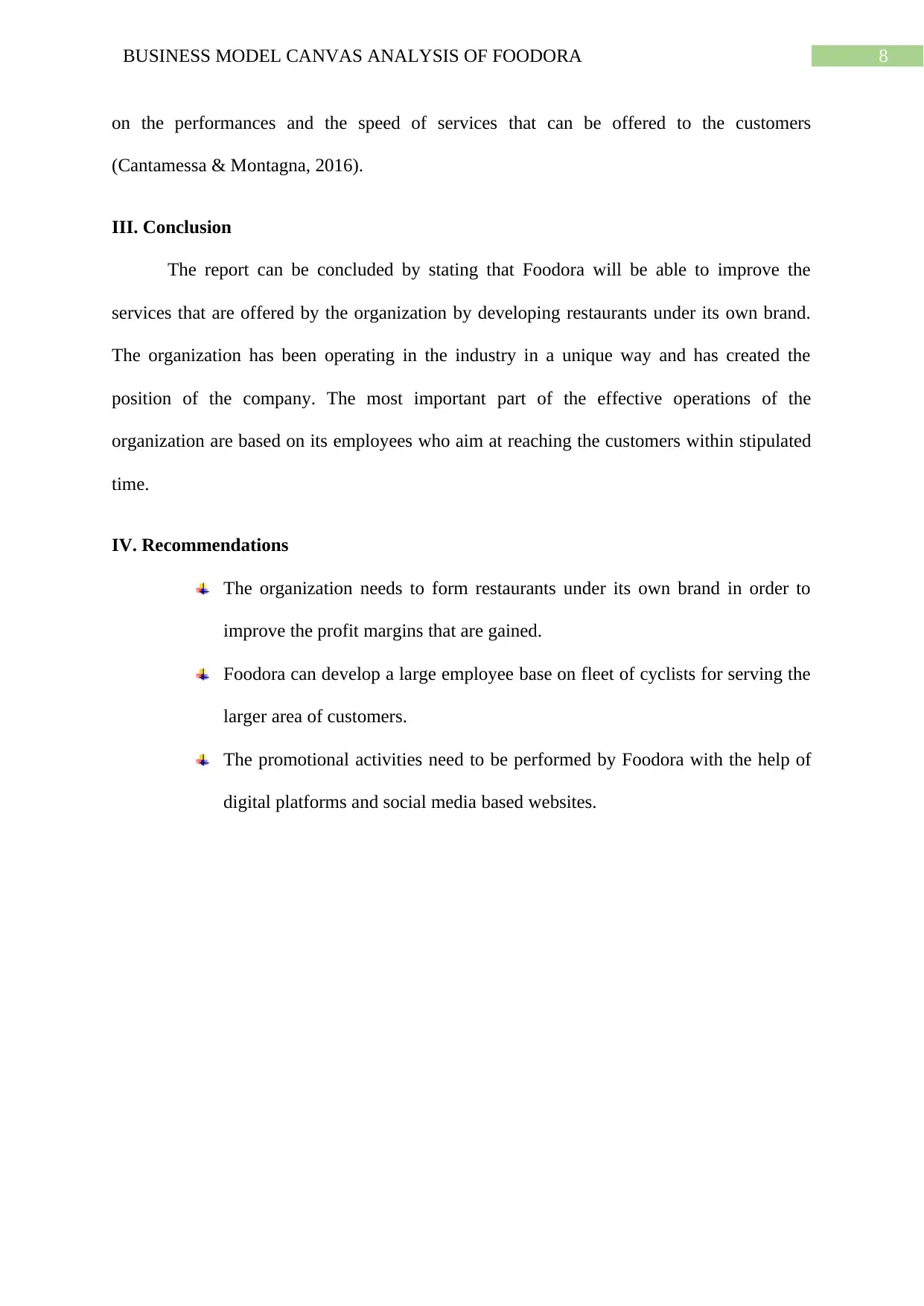
8BUSINESS MODEL CANVAS ANALYSIS OF FOODORA
on the performances and the speed of services that can be offered to the customers
(Cantamessa & Montagna, 2016).
III. Conclusion
The report can be concluded by stating that Foodora will be able to improve the
services that are offered by the organization by developing restaurants under its own brand.
The organization has been operating in the industry in a unique way and has created the
position of the company. The most important part of the effective operations of the
organization are based on its employees who aim at reaching the customers within stipulated
time.
IV. Recommendations
The organization needs to form restaurants under its own brand in order to
improve the profit margins that are gained.
Foodora can develop a large employee base on fleet of cyclists for serving the
larger area of customers.
The promotional activities need to be performed by Foodora with the help of
digital platforms and social media based websites.
on the performances and the speed of services that can be offered to the customers
(Cantamessa & Montagna, 2016).
III. Conclusion
The report can be concluded by stating that Foodora will be able to improve the
services that are offered by the organization by developing restaurants under its own brand.
The organization has been operating in the industry in a unique way and has created the
position of the company. The most important part of the effective operations of the
organization are based on its employees who aim at reaching the customers within stipulated
time.
IV. Recommendations
The organization needs to form restaurants under its own brand in order to
improve the profit margins that are gained.
Foodora can develop a large employee base on fleet of cyclists for serving the
larger area of customers.
The promotional activities need to be performed by Foodora with the help of
digital platforms and social media based websites.
⊘ This is a preview!⊘
Do you want full access?
Subscribe today to unlock all pages.

Trusted by 1+ million students worldwide
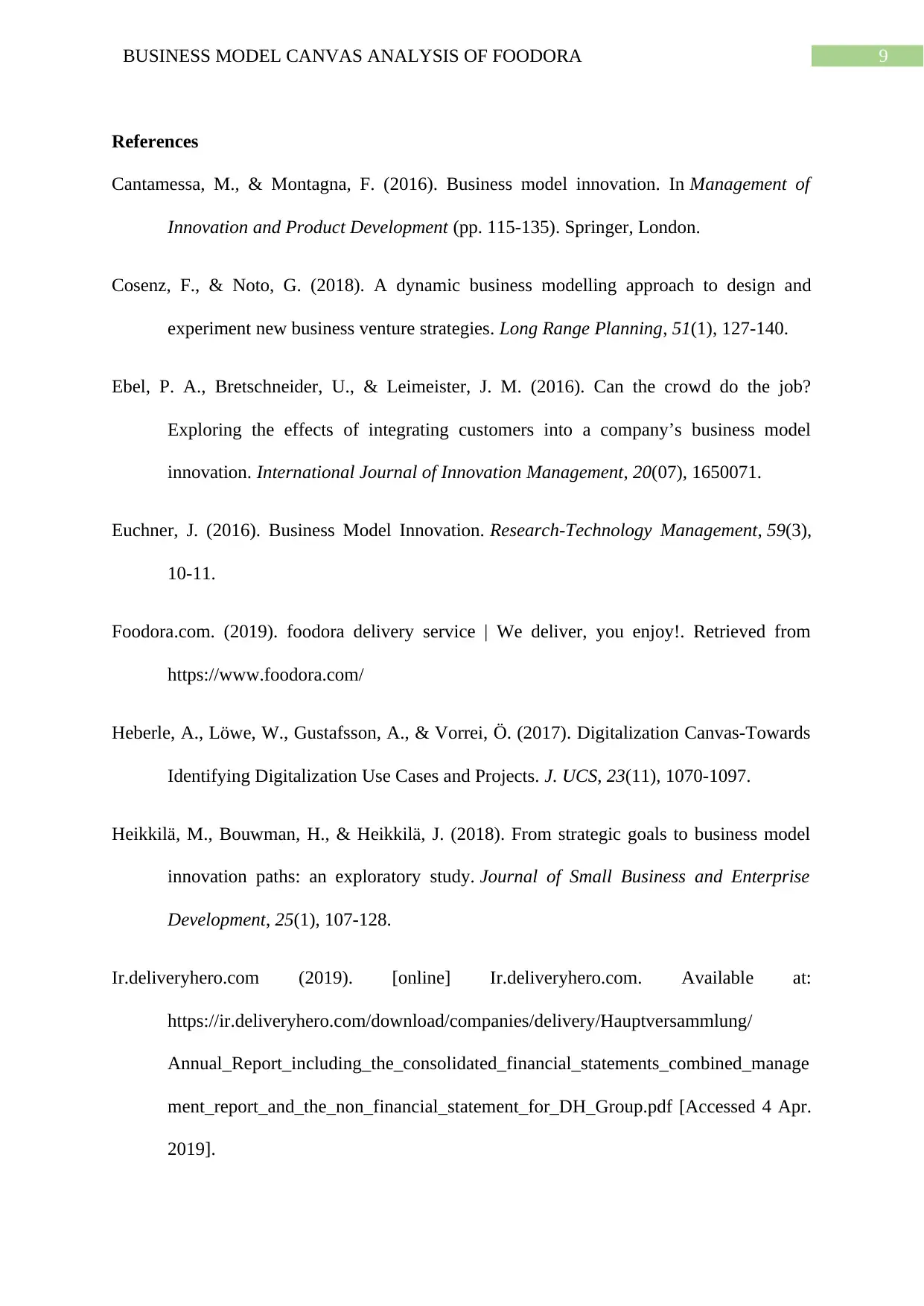
9BUSINESS MODEL CANVAS ANALYSIS OF FOODORA
References
Cantamessa, M., & Montagna, F. (2016). Business model innovation. In Management of
Innovation and Product Development (pp. 115-135). Springer, London.
Cosenz, F., & Noto, G. (2018). A dynamic business modelling approach to design and
experiment new business venture strategies. Long Range Planning, 51(1), 127-140.
Ebel, P. A., Bretschneider, U., & Leimeister, J. M. (2016). Can the crowd do the job?
Exploring the effects of integrating customers into a company’s business model
innovation. International Journal of Innovation Management, 20(07), 1650071.
Euchner, J. (2016). Business Model Innovation. Research-Technology Management, 59(3),
10-11.
Foodora.com. (2019). foodora delivery service | We deliver, you enjoy!. Retrieved from
https://www.foodora.com/
Heberle, A., Löwe, W., Gustafsson, A., & Vorrei, Ö. (2017). Digitalization Canvas-Towards
Identifying Digitalization Use Cases and Projects. J. UCS, 23(11), 1070-1097.
Heikkilä, M., Bouwman, H., & Heikkilä, J. (2018). From strategic goals to business model
innovation paths: an exploratory study. Journal of Small Business and Enterprise
Development, 25(1), 107-128.
Ir.deliveryhero.com (2019). [online] Ir.deliveryhero.com. Available at:
https://ir.deliveryhero.com/download/companies/delivery/Hauptversammlung/
Annual_Report_including_the_consolidated_financial_statements_combined_manage
ment_report_and_the_non_financial_statement_for_DH_Group.pdf [Accessed 4 Apr.
2019].
References
Cantamessa, M., & Montagna, F. (2016). Business model innovation. In Management of
Innovation and Product Development (pp. 115-135). Springer, London.
Cosenz, F., & Noto, G. (2018). A dynamic business modelling approach to design and
experiment new business venture strategies. Long Range Planning, 51(1), 127-140.
Ebel, P. A., Bretschneider, U., & Leimeister, J. M. (2016). Can the crowd do the job?
Exploring the effects of integrating customers into a company’s business model
innovation. International Journal of Innovation Management, 20(07), 1650071.
Euchner, J. (2016). Business Model Innovation. Research-Technology Management, 59(3),
10-11.
Foodora.com. (2019). foodora delivery service | We deliver, you enjoy!. Retrieved from
https://www.foodora.com/
Heberle, A., Löwe, W., Gustafsson, A., & Vorrei, Ö. (2017). Digitalization Canvas-Towards
Identifying Digitalization Use Cases and Projects. J. UCS, 23(11), 1070-1097.
Heikkilä, M., Bouwman, H., & Heikkilä, J. (2018). From strategic goals to business model
innovation paths: an exploratory study. Journal of Small Business and Enterprise
Development, 25(1), 107-128.
Ir.deliveryhero.com (2019). [online] Ir.deliveryhero.com. Available at:
https://ir.deliveryhero.com/download/companies/delivery/Hauptversammlung/
Annual_Report_including_the_consolidated_financial_statements_combined_manage
ment_report_and_the_non_financial_statement_for_DH_Group.pdf [Accessed 4 Apr.
2019].
Paraphrase This Document
Need a fresh take? Get an instant paraphrase of this document with our AI Paraphraser

10BUSINESS MODEL CANVAS ANALYSIS OF FOODORA
Lopes, S. C. P., Lopes, H. E. G., Coleta, K. G., & Rodrigues, V. C. (2019). Business Models
and Competitive Advantage: A Dynamic Approach. Iberoamerican Journal of
Strategic Management (IJSM), 18(1), 90-105.
Matsumae, A., & Burrow, K. (2016). Business model generation canvas as a method to
develop customer-oriented service innovation. In Serviceology for Designing the
Future(pp. 551-565). Springer, Tokyo.
Philipson, S. (2016). Radical innovation of a business model: is business modelling a key to
understand the essence of doing business?. Competitiveness Review, 26(2), 132-146.
Stampfl, G. (2015). The process of business model innovation: an empirical exploration.
Springer.
Lopes, S. C. P., Lopes, H. E. G., Coleta, K. G., & Rodrigues, V. C. (2019). Business Models
and Competitive Advantage: A Dynamic Approach. Iberoamerican Journal of
Strategic Management (IJSM), 18(1), 90-105.
Matsumae, A., & Burrow, K. (2016). Business model generation canvas as a method to
develop customer-oriented service innovation. In Serviceology for Designing the
Future(pp. 551-565). Springer, Tokyo.
Philipson, S. (2016). Radical innovation of a business model: is business modelling a key to
understand the essence of doing business?. Competitiveness Review, 26(2), 132-146.
Stampfl, G. (2015). The process of business model innovation: an empirical exploration.
Springer.
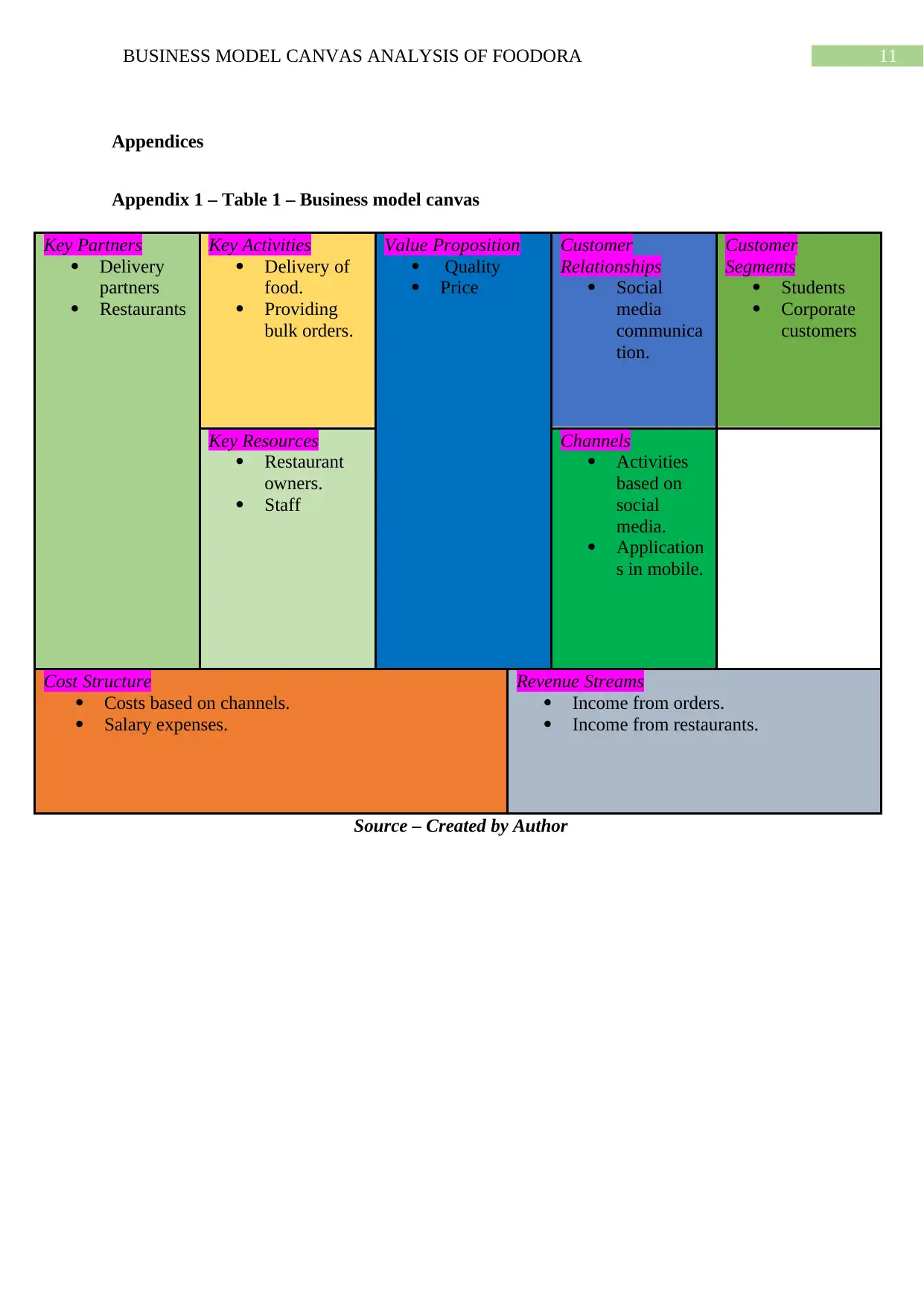
11BUSINESS MODEL CANVAS ANALYSIS OF FOODORA
Appendices
Appendix 1 – Table 1 – Business model canvas
Key Partners
Delivery
partners
Restaurants
Key Activities
Delivery of
food.
Providing
bulk orders.
Value Proposition
Quality
Price
Customer
Relationships
Social
media
communica
tion.
Customer
Segments
Students
Corporate
customers
Key Resources
Restaurant
owners.
Staff
Channels
Activities
based on
social
media.
Application
s in mobile.
Cost Structure
Costs based on channels.
Salary expenses.
Revenue Streams
Income from orders.
Income from restaurants.
Source – Created by Author
Appendices
Appendix 1 – Table 1 – Business model canvas
Key Partners
Delivery
partners
Restaurants
Key Activities
Delivery of
food.
Providing
bulk orders.
Value Proposition
Quality
Price
Customer
Relationships
Social
media
communica
tion.
Customer
Segments
Students
Corporate
customers
Key Resources
Restaurant
owners.
Staff
Channels
Activities
based on
social
media.
Application
s in mobile.
Cost Structure
Costs based on channels.
Salary expenses.
Revenue Streams
Income from orders.
Income from restaurants.
Source – Created by Author
⊘ This is a preview!⊘
Do you want full access?
Subscribe today to unlock all pages.

Trusted by 1+ million students worldwide
1 out of 14
Related Documents
Your All-in-One AI-Powered Toolkit for Academic Success.
+13062052269
info@desklib.com
Available 24*7 on WhatsApp / Email
![[object Object]](/_next/static/media/star-bottom.7253800d.svg)
Unlock your academic potential
Copyright © 2020–2025 A2Z Services. All Rights Reserved. Developed and managed by ZUCOL.





